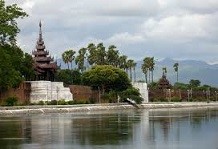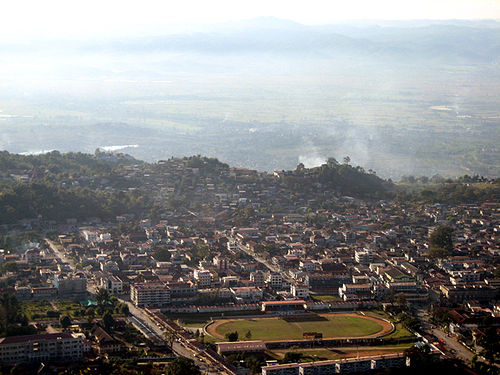Myanmar history dates back to the early 11th Century when King Anawrahta unified the country and founded the first Myanmar Empire in Bagan more than 20 years before the Norman Conquest of England in 1066. The second Myanmar Empire was founded in mid 16th Century by king Bayinnaung King Alaungpaya founded the last Myanmar Dynasty in 1752. Myanmar became a British colony but only after three Anglo Myanmar wars in 1825, 1852 and 1885. During the second World War, Myanmar was occupied by the Japanese from 1942 till the return of the Allied Forces in 1945. Myanmar has become a sovereign independent state since 4th January 1948 after 62 years under the colonial administration.
Myanmar has at total area of 676,577 sq-km. Geographically, Myanmar is the largest country in South-East Asian Peninsula sharing borders with Bangladesh, India, China, Laos and Thailand.
Myanmar has the effects of the Monsoon in different parts of the country. Temperature varies from 38°C to 19°C humidity from 82.8% to 66%
Myanmar has three distinctive seasons, Hot season (March to May), Rainy season (June to October) and Cool season (November to February). The rainy season being the longest period of a year, the climate is favorable to cultivation, and consequently the major industry of the country is agriculture.
There are altogether 135 groups of nationalities in Myanmar. The major races are Kachin, Kayah, Kayin, Chin, Bamar, Mon, Rakhine and Shan. Among them, Bamar is the majority: 69% of the total population.
Every group of nationality speaks its own language or dialect. But the official language is Myanmar which is spoken all over the country. English also is widely spoken and understood especially in the cities like Yangon, Mandalay, Bagan and so on.
Over 80% of Myanmars are Buddhist. There are also Christians, Muslims and Hindus. There is full freedom of worship for followers of other religious. Christian missionaries have been active in Myanmar for over 150 years. Among them, the American Baptists were first on the scene.
Myanmar lies on the crossroads of two of the world’s great civilizations-China and India. Its culture is a blend of both interspersed with Myanmar native traits and characteristics. Buddhism has great influence on daily life of the Myanmars. The people have preserved the traditions of close family ties, respect for the elders, reverence for Buddhism and simple native dress.
The basic Myanmar food is mainly rice and curry. Some Myanmar curries are spicy and there is always fish paste in many forms with salad. Soup mostly made of vegetables is taken together with rice and other dishes.
Mohinga, rice noodles with fish gravy is favorite for breakfast. Ohn-No-Khaukswe (noodles with coconut chicken gravy) is the most popular among Myanmar foods.
Favorites desserts are Sanwin-ma-kin (Myanmar sweetcakes made with semolina, sugar, egg, butter and coconut, Myanmar style Banana cakes, Kyaukchaw (sea weed- jelly) and gagger. Chinese foods both contonese and Fukienese are popular among Myanmars and there are Chinese Restaurants in almost every town. Indian foods like Kababs, Biryani are also popular with Myanmar palate. European food is available only at restaurants and hotels.
Light causal wear for all year round. Thin cotton is the best. A warm sweater or light jacket for the cool season especially when visiting upper Myanmar, like Shan state (Taunggyi-Inle, Kalaw, Pandaya), Mandalay and Bagan. An umbrella will be useful during the rainy season. Sandals or slippers are convenient as all foot wears must be taken of when entering the precincts of Pagodas and monasteries. Visitors should not wear shorts or briefs when visiting Pagodas and monasteries.
Drink only bottled or boiled water and green tea (Chinese Tea).
Bargaining is an art long practised in Asian countries including Myanmar. So feel free to ask for a proper discount when shopping in places where prices are not marked. Be careful in dealing with sidewalk vendors who may not offer genuine goods at fair prices. Myanmar arts and crafts, mostly, pure handmade are best souvenirs and prices are very reasonable. Lacquerware, wood and ivory carvings tapestries , silverware, brassware, silk and cotton fabrics and shoulder bags are some of the favorite items. For jewelry, there are Myanmar ruby, sapphire, jade and pearls available at Myanmar gems shops.
Myanmar time is 6:30 hours ahead of Green-which Mean time.
230 volts 50 cycles.
Myanmar currency is called Kyat and comes in notes of 1000,500,200,100,90,50,45,20, 10,5 and 1 kyat.
All foreigners entering Myanmar must have a valid visa issued by the Myanmar Embassies and Consulates abroad. There are two kinds of visas applicable to Tourists:
Package Tour visas can be obtained for persons arranging tours through registered local tour operators and their agents abroad.
FIT visas are for persons not making any arrangements for sight-seeing etc.: with local tour operator but prefer to explore the country on their own.
All tourist visas are valid for 28 days with an option for extension.
Airport Tax is USD 10 plus additional USD 2 as insurance per person on international departure.
All FIT visa holders are required to change USD 200 into equivalent Foreign Exchange Certificates (FEC) on arrival. Package tour visa holders are exempted from this rule.
Only major hotels will accept credit cards or travellers' cheques. Most commercial transactions are done in cash, so bring cash to avoid any disappointments. Also United States dollars are easier to exchange than other currencies. Cash can be withdrawn fromcredit card accounts of Visa or American Express, but this service is available only in Yangon.
Myanmar International SOS Ltd. offers 24 hour Medical Assistance with emergency evacuations, medically supervised repatriations, dispatch of doctors or specialists. Located at the Renaissance Inya Lake Hotel, Kaba Aye Pagoda Road.
Tel : 95-1-667 879
Fax : 95-1-667 866
24 Hr. Alarm Center 95-1-667877
Mosqiuto repellent and sunscreen are a must. Try to avoid going out in the middy sun when it’s very hot. Don’t forget to bring medication you would normally use in emergencies, such as antibiotics etc. Most medicines are available but maybe not the brand you normally use.

Mandalay is the second largest city after Yangon and the last captial of Myanmar’s monarchy. It is located at 668km north from Yangon. The city was founded in 1857 by King Mindon.
Read More
The capital at Shan State. About 454 miles from Yangon. A hill station, over 1,430 meter above sea-level. By car all the way in 16 hours. By train up to Nyaung Shwe and thence to Taunggyi by car.
Read More